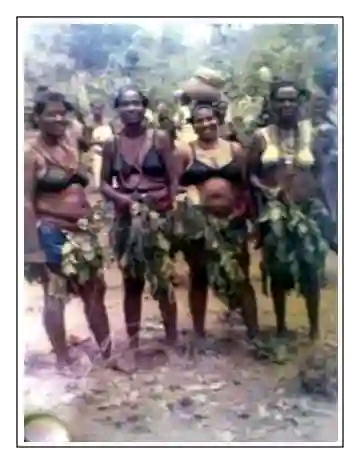The Kuteb people populate Takum/Ussa local government area and Yangtu Special Development Area, Southern Taraba. This people have an uncommon accommodating disposition. They are industrious and hardworking. Agriculture is the backbone of their economy. To crown it all, they have a rich and grounded cultural heritage that is celebrated with abundant pomp and pageantry.
The Kuteb people before now worshiped sun and thunder because they believed it had powers to guide their kindred and also provide them with enough food and water. The Kukwen, who is the priest of the Kuteb race shaves and bathes once in a year. This is to avoid any form of misfortune and disaster.
Today, the Kuchicheb festival is a cultural and religious festival and it’s an annual festival of thanksgiving to Rimam (God) for his abundant blessing and for plentiful harvest in the forthcoming year. It is witnessed by prominent sons and daughters of Kuteb extraction. During the festival, it’s not unusual to sight scantily dressed men and women as it is believed that the Kuteb man can only come into close contact with the almighty by using natural objects such as leaves and animal skin to cover themselves.
According to the people, the presence of the almighty can only be felt or seen when a man insulates himself from the material things of this world. The festival is usually celebrated in the month of March every year, there is no handpicked date for it to kick-off and it usually runs for a whole week.
Before the date of the festival can be announced, the Chief priest (Kukwen Rikwen) have to meet with the other priests (Akwen) and together, they consult the gods of the land who would now reveal the date the festival must commence. It is tagged “the holy week”. Three days before the commencement of the Kuchicheb festival, some elders and the priest would converge at the shrine of “Iki-Fang” (Farm deity) to ask for go-ahead to enter into the “holy week”. The response of the ancestors is indicated by the arrival of a moth (Tapupu) or a spider (Kamsun) or a bird (U-zwin).
Furthermore, since it is a holy week, people are enjoined to purify their hearts by settling their differences. They are also urged to be hospitable to visitors as well as neighbors and there should be no provocation of any sort. Even children are not to be maltreated or harassed while sexual activities are prohibited during the holy week.
The festival opens with a ritual usually performed by heads of the extended household. The ritual involves dipping palm leaves in a clay pot filled with water and sprinkling it on the ground thrice while repeating the phrase “Uwong Jim shwur Shwur Shwur (It’s all peaceful, peaceful, peaceful) at every interval.
“The feast begins with the arrival of the Masquerade (IKI) which signifies the incarnate spirits of the ancestor in a procession. Men, women, boys, girls, old and young would appear in their best attires”
The feast begins with the arrival of the Masquerade (IKI) which signifies the incarnate spirits of the ancestor in a procession. Men, women, boys, girls, old and young would appear in their best attires. Assorted food and meat that had been drenched in palm oil are served and large gourds of the locally brewed corn beer (Burukutu or Uzwab) are consumed in their numbers by both men and women.













The seventh day is the climax of the festival. The venues of the dance shift from individual compounds to a central square which is usually near the palace of the paramount chief of Takum (Ukwe Takum). From this central square, the pilgrimage to “Iya Ussa”; a place believed to be the abode of the Kuteb ancestors soon after they descended from Surkwen Ussa (Mount Ussa) begin. The purpose of this pilgrimage is to obtain the holy fire, which is ignited and shared amongst the twelve elders representing the twelve tribes of Kuteb. The elders would hold out the fire in the manner of the Olympic torch and trek several kilometers to their present settlement where all the previous fire are put out as the sacred fire becomes the new source of the fire in the society.
Kuchicheb Festival for Most participants in the pilgrimage are clad in traditional costumes made of leaves, animal skin, beaded girdles and locally dyed clothes. These costumes are used in covering only the private parts while all other parts of the body are bare. Locally manufactured weapons such as spears, machetes, knives are openly and menacingly brandished while fumes from guns rent the air making the atmosphere more exciting and recharged. However, none of these weapons are to be used on ants or animals throughout the period of the festival. As the crowd progresses, the women sway their hips from left to right amidst laughter and joy sing songs of praise that recount gallant achievements of great men of Kuteb land.
At the end of the ceremony, the priest and elders gather again at the shrine with the gourd containing any of the following- spider, moth or bird. After praying and sacrificing to the gods, the gourd is open and the content is let out via the route it came. The palm leaves used in dressing the masquerades are tied to the Iki-Fang and the trees within the vicinity of the dancing grounds signifying the end of the Kuchicheb festival for the year.
Kwararafa Mass Media



